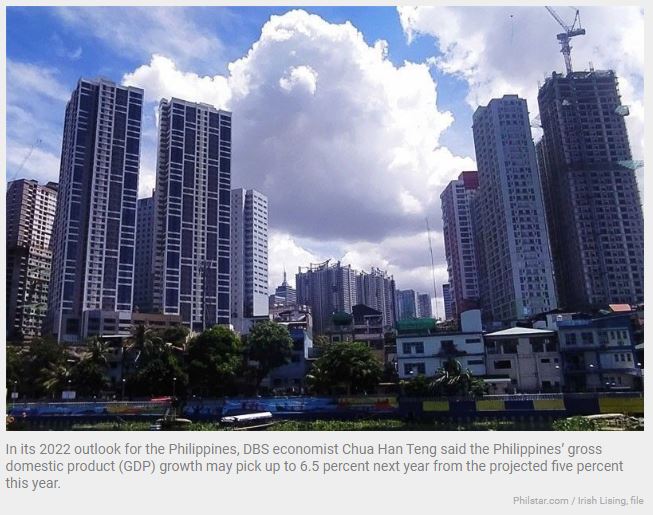Philippines: Return to pre-pandemic levels seen in H2 next year
MANILA, Philippines — The Philippines is expected to return to pre-pandemic levels in terms of domestic output by the second half of next year, slower than neighboring countries in Southeast Asia, DBS Bank Ltd. of Singapore and Japanese investment bank Nomura said in separate reports.
In its 2022 outlook for the Philippines, DBS economist Chua Han Teng said the Philippines’ gross domestic product (GDP) growth may pick up to 6.5 percent next year from the projected five percent this year.
“Our projected growth trajectory suggests that real GDP would retrace to 2019 levels sometime in the second half of 2022, slower than ASEAN peers,” Teng said.
The projected growth next year is the second fastest among ASEAN countries, next to Vietnam’s eight percent and faster than Malaysia’s five percent, Indonesia’s 4.8 percent, Singapore’s and Thailand’s 3.5 percent as well as Taiwan’s 2.8 percent.
The Philippines slipped into recession in 2020 with a record 9.6 percent GDP contraction as the economy stalled due to the pandemic.
“The Philippines has been mired in a rocky 2021 amid new COVID waves and stringent virus restrictions that have seen the authorities dial down their growth forecast to four to five percent from six to seven percent,” Teng said.
“The economy has returned to its recovery path starting from the third quarter of 2021. We think that receding virus caseloads, the shift toward smaller-scale lockdowns, and rising vaccinations and natural immunity set the stage for a moderate recovery from the fourth quarter of 2021,” Teng said.
He said domestic demand would drive the economic recovery in 2022, helped by a cyclical recovery in private consumption and investment.
“Private consumption should receive tailwinds from further improvements in mobility and economic reopening, aided by vaccinations reaching critical mass by mid-year. Labor market and income conditions are also likely to improve, while overseas remittances remain healthy,” he said.
According to DBS, Filipinos household balance sheets have been scarred and severely damaged by the COVID-19 pandemic, as savings have been significantly depleted, constraining medium-term household spending.
The final push of the Build Build Build program in the remaining months of the Duterte government could buoy investment activity in the country.
Infrastructure projects corner 5.3 percent of GDP under the proposed 2022 national budget.
In a separate report, Nomura chief ASEAN economist Ruben Paracuelles said economic recovery in the Philippines has been lagging in the region and is expected to continue until next year.
Nomura expects the Philippine economy growing by 6.5 percent next year and 5.2 percent in 2023.
Paracuelles said growth would likely be impacted by low vaccination rates and elevated political uncertainty ahead of national elections in May 2022.
“The Philippines, where we forecast 2022 GDP growth of 6.5 percent, will remain the weakest link in the region, in our view, due to elevated political uncertainty because of the elections in May 2022 and the low absorptive capacity of local government units in a transition year when more functions are being devolved to them as required in a 2019 Supreme Court ruling, implying some risk of fiscal policy paralysis,” Paracuelles said.
Source: https://www.philstar.com/business/2021/12/09/2146616/return-pre-pandemic-levels-seen-h2-next-year


 Thailand
Thailand




